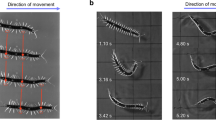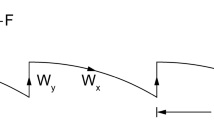Abstract
IT HAS been accepted generally that the waves of bending observed in swimming vertebrates are produced by contraction on the concave side of each bend of the body at any point within the cycle of movement1–3. “Waves of contraction” are imagined to pass down the serial mytomes with the velocity of the propagated bends. Another concept, designed primarily to explain snake locomotion4, differs by a 90° shift in the timing of contraction on the bending wave, accounting for propulsion but resulting in illogical analysis of fish movement5. The former interpretation gives no explanation of the source of locomotory thrust, assuming falsely that the muscular activity required for a given body position is similar whether the position is held or passed through in locomotion. The dominant responsibility of locomotory activity is the propagation rather than the formation of bends, but how is propagation achieved against external resistance? Relevant electromyography of spinal dogfish6,7 has not been related to this mechanical problem. I present here a preliminary report of electromyographic studies of developmental stages of the palmate newt, Triturus helveticus (Razoumowsky), and adult tench, Tinca tinca L., which show that undulatory propulsion in some animals does not involve waves of contraction and that the “waves” recorded in others function in reducing lateral oscillation anteriorly and adapting tail flexibility to different swimming speeds.
This is a preview of subscription content, access via your institution
Access options
Subscribe to this journal
Receive 51 print issues and online access
$199.00 per year
only $3.90 per issue
Buy this article
- Purchase on Springer Link
- Instant access to full article PDF
Prices may be subject to local taxes which are calculated during checkout
Similar content being viewed by others
References
Coghill, G. E. J. comp. Neurol., 19, 83–105 (1909).
Breder, C. M. Zoologica, New York, 4, 159–297 (1926).
Gray, J. J. exp. Biol., 10, 88–104 (1933).
Gray, J. Q. Jl microsc. Sci., 94, 551–578 (1953).
Gray, J., in Essays in Marine Biology (edit. by Marshall, S. M., and Orr, A. P.), 1–16 (Oliver and Boyd, Edinburgh, 1953).
Grillner, S. Expl Brain Res., 20, 459–470 (1974).
Grillner, S., Perret, C. and Zangger, P. Brain Res., 109, 255–269 (1976).
Gallien, L. and Bidaud, O. Bull. Soc. zool. Fr., 84, 22–32 (1959).
Keeter, J. S., Pappas, G. D. and Model, P. G. Devi Biol. 45, 21–33 (1975).
Hayes, B. P. Anat. Embryol., 147, 345–354 (1975).
Blackshaw, S. E. and Warner, A. E. J. Physiol., Lond., 246, 73P–74P (1975); ibid., 255, 209–230 (1976).
Lighthill, M. J. J. Fluid Mech., 9, 305–317 (1960).
Author information
Authors and Affiliations
Rights and permissions
About this article
Cite this article
BLIGHT, A. Undulatory swimming with and without waves of contraction. Nature 264, 352–354 (1976). https://doi.org/10.1038/264352a0
Received:
Accepted:
Issue Date:
DOI: https://doi.org/10.1038/264352a0
This article is cited by
-
Where are we in understanding salamander locomotion: biological and robotic perspectives on kinematics
Biological Cybernetics (2013)
-
Early development of descending pathways from the brain stem to the spinal cord in Xenopus laevis
Anatomy and Embryology (1984)
-
Swimming and other centrally generated motor patterns in newt embryos
Journal of Comparative Physiology ? A (1983)
Comments
By submitting a comment you agree to abide by our Terms and Community Guidelines. If you find something abusive or that does not comply with our terms or guidelines please flag it as inappropriate.



